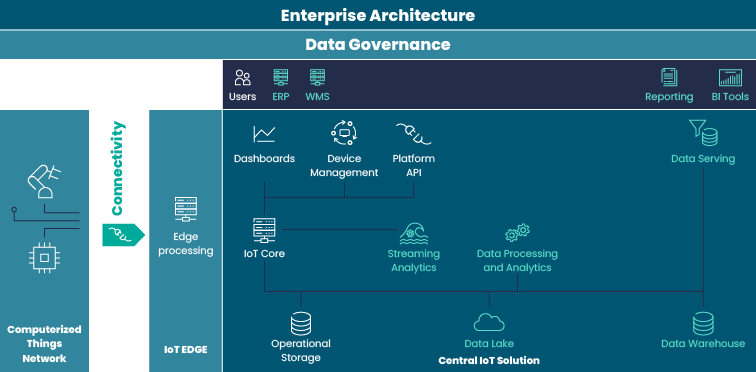Understanding the collected data is a key step for every company – it means gaining more value from data. This is the stage when the company aims to understand the data coming from the machines: mostly measurements, and events. To achieve this, it is necessary to integrate enterprise knowledge into the IoT solution. Read on to find out why a CBM maintenance plan is necessary for your organization, and how can you lower overall maintenance costs thanks to techniques used in CBM.
- 1. Exploring the World of Condition-Based Maintenance (CBM)
- 2. Before you implement CBM program, understand your data first
- 3. What is Condition-Based Maintenance? How does it work?
- 4. CBM vs Preventive Maintenance: understanding the difference
- 5. Challenges in implementing Condition-Based Maintenance
- 6. Maximizing Efficiency with Condition-Based Maintenance Programs
- 7. Condition-based monitoring case study
Exploring the World of Condition-Based Maintenance (CBM)
Over the passing decade, we could observe rising interest in various maintenance concepts throughout the manufacturing, oil & gas, chemicals, metals, and mining industries. Although predictive maintenance is on the upswing, with interest tripling, condition-based maintenance is still a needed and valued maintenance method – it allows us to react quickly when measured signals are at alarming levels.
Reactive maintenance does not always allow us to ensure the reliability of machines to the appropriate level. Condition-Based Maintenance (CBM), in turn, is a strategy that focuses on monitoring the condition of operating equipment to determine when maintenance should be performed. Instead of performing maintenance at set intervals, CBM programs rely on data collected from sensors and other monitoring devices to identify potential issues before they result in equipment failure.

Before you implement CBM program, understand your data first
Understanding the data is related to data contextualization: putting the incoming data from devices into some context to comprehend it better. Once done, the company can start analyzing it, which brings even more value and insights. This can be achieved in two ways, explained below.
Streaming analytics
1) For fast analytics, the streaming analytics component is used which works exactly at the time the data arrives on the platform. This way it is possible to directly compare the current measurement with some contextual data.
2) The second way is a batch way of aggregating reasoning over longer periods. For that, data analysis techniques are used. Due to operational storage limited capacity (the data cannot be stored forever locally) data needs to be offloaded into, for example, a data lake solution for long-time storage and further analysis.
On top of that, data processing and analytics solutions are built to draw insights out of Big Data storage. Once done, the calculations are stored in the data warehouse and exposed through the data serving layer. Then data is made available to business users via custom reporting or any Business Intelligence tools.
Why is it important to understand the data
The level of understanding of data unlocks new possibilities for businesses. The flagship of those is condition-based maintenance.
CBM is a method based not on intuition, machine wear, or time of use. This is where the hard facts come into play. Condition-monitoring means collecting measurements and events from devices to compare them (possibly near real-time) with contextual data and reason whether something wrong is going on with the devices.
What is Condition-Based Maintenance? How does it work?
The CBM concept is based on an approach in which maintenance activities take place based on machine condition-related data, collected through sensors. The goal of this approach is to reduce unnecessary verifications undertaken by the maintenance teams and reduce machine downtime and, ultimately, cost savings.
Benefits of Condition-Based Maintenance
Quicker issue solution
When the current measurements are out of defined ranges, the system automatically can generate alerts that are instantly visible to operators and maintenance staff so they can react quickly to limit damages – for example, they can either undertake corrective action or stop the device on the shop floor before it completely breaks down.
Limited downtime
With CBM, it is possible to avoid unnecessary work related to performing scheduled device checks that sometimes turn out to be unnecessary. Also, condition-based maintenance improves operational capabilities. You can merge your data with enterprise systems like SAP to gain more value from it.
CBM vs Preventive Maintenance: understanding the difference
Condition-based maintenance is a type of preventive maintenance. That means preventive maintenance is a wider subject in which the general aim is to prevent breakdowns before they happen.
The main benefit of CBM is that it can be performed while the asset is working, and thus it reduces the probability of operational disruption. CBM has some limitations though – for example, it calls for expertise in data analysis and incurring the cost of sensors and staff training. It also requires expert knowledge to build up the database of context data containing “healthy” and “unhealthy” ranges for parameters being measured.
Key monitoring techniques in CBM
Condition-based maintenance method is aimed at monitoring the actual condition of the asset by checking a machine for specific indicators (such as measurements, visual inspection, checking on performance data, and scheduled tests). The major techniques in Condition-Based maintenance include measuring such parameters as:
- temperature,
- vibration,
- pressure,
- speed,
- humidity
- lubrication.
- usage hours,
- fuel levels,
- air quality.
Effective Condition Monitoring Techniques
Implementing a condition-based maintenance strategy can greatly improve the efficiency of maintenance efforts by focusing on the health of critical assets.
Key monitoring techniques include:
- Vibration monitoring and analysis – with accelerometers and spectrum analyzers
- Oil monitoring and analysis – sampling and testing lubricants
- Radiation analysis – monitoring and measuring equipment thermal anomalies
- Acoustic analysis – catching the sound waves of faults/cracks
- Real-time analysis of critical electrical parameters – analyzing motors’ / generators’ electrical parameters.
Challenges in implementing Condition-Based Maintenance
- Maintenance software and solution investment – CBM software solutions, including asset monitoring, make it easier to control their live status. Choosing and purchasing software is not an easy task, especially since there are many maintenance solutions available on the market.
- Proper knowledge and training of employees – regularity is essential in this method of asset maintenance. It is therefore necessary to train operators on how to conduct maintenance work based on data received from equipment. CBM implementation requires also expert knowledge about operated assets to properly populate contextual data base with “healthy” ranges for measured values and parameters.
- Systematic approach to maintenance – it is not enough to decide to implement a specific plan. CBM will require thinking through both the technical and financial aspects of maintenance, including ensuring the availability of machines and allocating staff. That requires organizational changes that support new approach to maintenance which is more dynamic. It is now based on changing conditions in the assets and not on static schedules anymore as in the traditional preventive approach.
Overcoming maintenance costs with CBM
Calculating the direct savings made thanks to Condition-Based Maintenance is necessary to provide a business justification for IoT investments. By direct costs we mean those associated with an investment in personnel, spare parts costs, or unexpected production downtimes.
Awareness of savings is not just a matter of benefits. Calculating the direct savings is a must. These savings will vary depending on the size of the plant and can range between a dozen thousand and several million dollars per year.
The direct savings are Savings = CostF – CostP, where F is the functional failure and P is the cost of fixing on time (before unexpected disruption and based on monitored criteria).
Maximizing Efficiency with Condition-Based Maintenance Programs
The challenges of implementing a CBM strategy may seem great, especially in the context of technology and needed investments and assessing the criticality of assets.
Strategies for Efficient Maintenance Management
Condition-based maintenance is a useful strategy, but not the only one for managing machine maintenance. It can be mixed with or substituted by other strategies as well. Here are some of them worth considering to make maintenance management as effective as possible.
- Predictive Maintenance – predictive maintenance undertakings are planned and scheduled according to complex sensor data analytics and Machine Learning algorithms trying to predict issues upfront based on historical data and current conditions.
- Preventive Maintenance – this is a subset of the “proactive” approach but less advanced than either “condition-based” or “predictive”. It relies on systematic inspections based on run-time of and asset.
- Reliability-Centered Maintenance (RCM) – this is a strategy in which organizations identify the physical assets that are necessary to manufacture their products. The goal is to keep this equipment availability at a maximum level.
- Total Productive Maintenance (TPM) – these are processes and techniques in the spirit of lean management that aim to optimize the operation and increase the efficiency of machines by keeping them running.
- Root Cause Analysis (RCA) – insightful cause analysis that makes it possible to identify appropriate responses.
- Computerized Maintenance Management Systems (CMMS) – the use of software to manage facilities in a centralized manner.
Real-time data collection and analysis in CBM
Today’s systems enable real-time or near-real-time data analysis.
Such analysis is great for many areas, enabling trend detection, market data analysis, fraud detection in the financial area, or better customer service through up-to-the-minute information. In companies where large amounts of data are produced, like manufacturing, real-time data analysis makes it possible: to optimize the supply chain, make decisions quicker, and monitor the performance of devices better.
 Streamline Your Application Maintenance Leszek Jaros, our Head of Telco and AMS Practice, is here to help you navigate the complexities of Application Maintenance Services. Book a consultation to boost your application's efficiency Schedule a meeting |
Condition-based monitoring case study
Our customer is a green energy sector leader who operates thousands of wind turbines around the world. Using condition-based monitoring techniques, they built a solution that compares enterprise knowledge and contextual data on operational devices.
Relating that to the actual data values of the devices, they started to generate alarms for the operators. However, thousands of wind turbines generate hundreds of measurements every hour, which results in dozens of alarms per hour. The solution was to use the stream of alarms as an additional event and to compare it against the enterprise knowledge for issues prioritizing purposes. It was also integrated with customer maintenance teams management systems to automatically create work orders. This way, the client improved operational staff productivity so that they could work on the most critical issues first.

Summary
The data starts to have meaning on a certain level of Internet of Things maturity. With condition-based maintenance, by combining current real-life data with past data, companies analyze trends and react swiftly before the device goes into failure mode. Maintenance based on condition monitoring saves time on unnecessary maintenance tasks.
- 1. Exploring the World of Condition-Based Maintenance (CBM)
- 2. Before you implement CBM program, understand your data first
- 3. What is Condition-Based Maintenance? How does it work?
- 4. CBM vs Preventive Maintenance: understanding the difference
- 5. Challenges in implementing Condition-Based Maintenance
- 6. Maximizing Efficiency with Condition-Based Maintenance Programs
- 7. Condition-based monitoring case study
